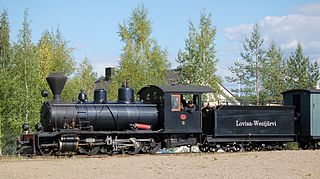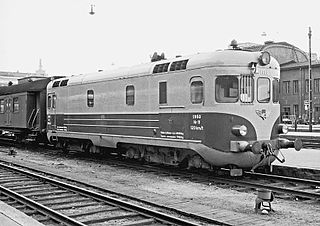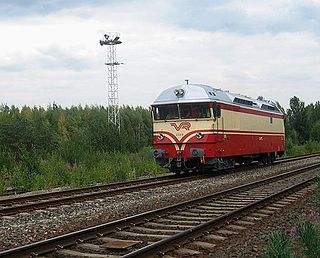
VR- Group Plc, commonly known as VR, is a government-owned railway company in Finland. VR's most important function is the operation of Finland's passenger rail services with 250 long-distance and 800 commuter rail services every day. With 7,500 employees and net sales of €1,251 million in 2017, VR is one of the most significant operators in the Finnish public transport market area.

The Finnish railway network consists of a total track length of 9,216 km (5,727 mi) of railways built with broad 1,524 mm commonly known as Russian gauge track, of which 3,249 km (2,019 mi) of track is electrified. Passenger trains are operated by the state-owned enterprise VR that runs services on 7,225 km (4,489 mi) of track. These services cover all major cities and many rural areas, though the coverage is less than the coverage provided by the bus services. Most passenger train services originate or terminate at Helsinki Central railway station, and a large proportion of the passenger rail network radiates out of Helsinki. VR also operates freight services. Maintenance and construction of the railway network itself is the responsibility of the Finnish Rail Administration, which is a part of the Finnish Transport Agency. The network consists of six areal centres, that manage the use and maintenance of the routes in co-operation. Cargo yards and large stations may have their own signalling systems.

Oy Tampella Ab was a Finnish heavy industry manufacturer, a maker of paper machines, locomotives, military weaponry, as well as wood-based products such as packaging. The company was based mainly in the Naistenlahti district of the city of Tampere.

Oy Lokomo Ab was a Finnish manufacturer of railroad equipment and steam locomotives, situated in Tampere, Finland. The company was founded in 1915 by a group of Finnish businesspeople, including Jalmar Castrén and Emil Aaltonen. The Lokomo factories in Tampere produced the MIR submersibles for the Soviet Academy of Sciences. They later merged into the Metso Corporation.

The F Class were a class of diesel locomotive shunters built by Dick Kerr Works for the Victorian Railways between 1951 and 1953. They are similar to the British Rail Class 11 and NS Class 600 shunting locomotives also built by English Electric during this period, but modified for use on the VR's 5 ft 3 in (1,600 mm) broad gauge.

The Sr1 is a class of electric locomotives built for VR of Finland. These 25 kV locomotives were built in the Soviet Union at the Novocherkassk Electric Locomotive Factory between 1973 and 1985. Two additional locomotives of this class were built at the VR Hyvinkää Machine Workshop in 1993 and 1995, number 3111 from spare parts and number 3112 from the original prototype locomotive that was never used by the VR. The official classification given by the manufacturer is VL70 or ES40.

The Jokioinen Museum Railway is located in Jokioinen, Finland. It is located on the last operating commercial narrow gauge railway in Finland, the 750 mm gauge Jokioinen Railway.

The Sr2 is a class of electric locomotives of the VR Group. They were built by SLM/ABB and later by Adtranz and finally Bombardier Transportation and assembled by Transtech Oy. They are closely based on the class Re 460 locomotives of Swiss Federal Railways.

The Sm3 Pendolino is a class of high-speed body-tilting trains operated by VR Group. It is a member of the Pendolino train family; its design is based on the ETR 460. The first two trainsets were assembled in Finland by Rautaruukki-Transtech in the mid-1990s. The rest of the series of eighteen EMUs were built by Fiat Ferroviaria between 2000 and 2006. The trains serve most of Finland's major cities such as Helsinki, Turku, Oulu and Joensuu with a maximum speed of 220 km/h (140 mph), although this speed is only attained between Kerava and Lahti. The train has a power output of 4,000 kW (5,400 hp) and weighs 328 tonnes.

The Dr16 is a class of diesel-electric locomotives used by VR. The 23 locomotives have a single, off-centre cab and are currently VR's most powerful diesel locomotives. Their nickname is "Iso Vaalee". They are presently mainly used on heavy freight services in northern Finland; their main passenger duty is the haulage of trains on the non-electrified line between Kemi and Kolari in Lapland. Dr16 locomotives were also used extensively on the line between Oulu and Rovaniemi, prior to the completion of the electrification of the line in 2004.

The VR Class Hr11 was the first class of line-haul diesel locomotives used by Valtionrautatiet. Only five units were built, all delivered by Valmet in 1955. The Maybach diesel engines used in the locomotives proved highly unreliable, resulting in a complete overhaul of the engine-transmission system in 1956–58, but this did not solve all of the reliability problems. The Hr11 series was withdrawn from service in 1972.

Hr1 class was the largest passenger express steam locomotive built in Finland. Twenty-two were built between the years 1937–1957. They were numbered 1000–1021.

The Dm12 is a diesel railcar operated by VR Group.

VR Class Pr1 was a tank steam locomotive for local passenger services of Finnish railways.

The Finnish Hv1 class was a 4-6-0 express passenger train locomotive. 42 were built between 1915 and 1921. They were numbered 545–578 and 648–655.

VR Class Dr12 was a heavy diesel locomotive of Valtionrautatiet. The first 6 locomotives were ordered in 1956. They entered service between 1959 and 1963. The locomotives were built by 2 manufacturers, Valmet and Lokomo, both based in Tampere. All Hr12 class locomotives with even numbers were produced by Valmet, while all odd numbers were produced by Lokomo. The locomotives were withdrawn in the early 1990s.

VR Class Dr13 was a heavy diesel locomotive used by VR Group. The Dr13 was designed by the French company Alstom. The class consisted of 54 locomotives, of which the first two were built by Alstom’s factory in Belfort, France and were shipped to Finland in 1962, while the rest were built in Tampere at the factories of Lokomo and Valmet. The first Dr13 series locomotive came to Finland on 24 October 1962. The Dr13 series was introduced between 1962–1963, and the last units were withdrawn by June 2000.

The VR Class Vk3 was originally called the Finnish Steam Locomotive Class I3. The Finnish State Railways ordered three similar classes of locomotives; The American-built Baldwin Class I1s, and the Class I2s and Class I3s, built at Tampella. All were tank locomotives, which did not have to be turned at terminal stations and could run in both directions at the same speed.

The VR Class Vk11 No 101 locomotive was purchased for testing on a six-mile stretch of track between Vuokatti and Sotkamo, where the use of steam locomotives had proved to be uneconomical due to low traffic. The locomotive was ordered from the Swedish act called Ab Slipmaterial of Sweden, and it was completed in 1930. The locomotive had a six-litre Wisconsin petrol-paraffin internal-combustion engine. In January 1931 the locomotive was delivered to Finland, it initially received the number Mt 101. Another very similar locomotive was ordered home in 1935. It was built by Lokomo in Finland and had an 80 hp paraffin Andros petrol-paraffin engine. It initially received the number Mt 102. In 1953 locomotive class designation was changed to Vk11, and in 1962 they were renumbered again to Tve-ko1 and Tve-ko2. Vk11 locomotives were broadly similar to each other, but there were a number of detail differences. Both were two-axle and weighing 12 tons. Both had engines that ran on kerosene / paraffin as fuel but required gasoline / petrol to start them. Locomotives had different lengths of 5.6 m and 6.0 m. Locomotive Vk11 No. 101 was tested on Vuokatti-Sotkamo line for four months. When the passenger rail in this case was discontinued, it was transferred to the locomotive workshop in Oulu on internal traffic. In 1935, the locomotive was placed in a shunting yard in Siuro. After that the locomotive was used at Vaasa and the workshop at Oulu as a shunter. The locomotive was withdrawn in 1962.

The class WDS-3 was a diesel-electric locomotive used by Indian Railways for shunting and doing departmental works. The model name stands for broad gauge (W), Diesel (D), Shunting (S) 3rd generation (3). The WDS-3 is used mostly in the Northern Railway Zone (NR). All these locomotives were withdrawn by the late 1990s.




















